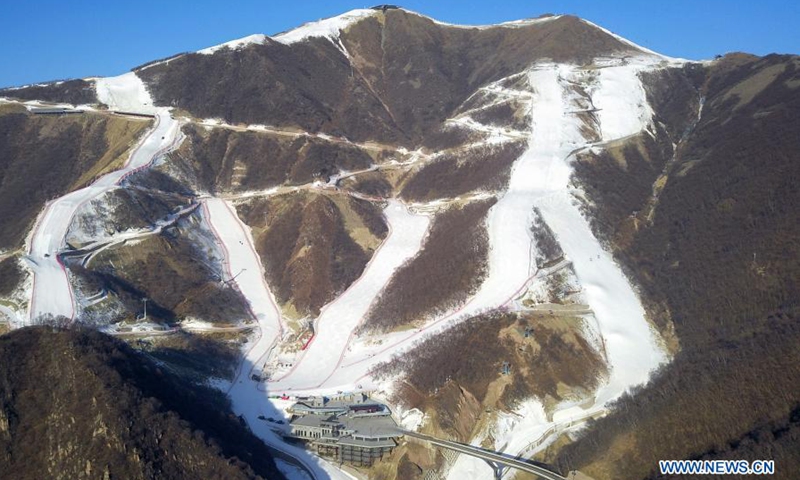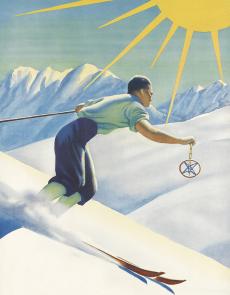SKIING HISTORY
Editor Seth Masia
Managing Editor Greg Ditrinco
Consulting Editor Cindy Hirschfeld
Art Director Edna Baker
Editorial Board
Seth Masia, Chairman
John Allen, Andy Bigford, John Caldwell, Jeremy Davis, Kirby Gilbert, Paul Hooge, Jeff Leich, Bob Soden, Ingrid Wicken
Founding Editors
Morten Lund, Glenn Parkinson
To preserve skiing history and to increase awareness of the sport’s heritage
ISHA Founder
Mason Beekley, 1927–2001
ISHA Board of Directors
Rick Moulton, Chairman
Seth Masia, President
Wini Jones, Vice President
Jeff Blumenfeld, Vice President
John McMurtry, Vice President
Bob Soden (Canada), Treasurer
Einar Sunde, Secretary
Richard Allen, Skip Beitzel, Michael Calderone, Dick Cutler, Ken Hugessen (Canada), David Ingemie, Joe Jay Jalbert, Henri Rivers, Charles Sanders, Christof Thöny (Austria), Ivan Wagner (Switzerland)
Presidential Circle
Christin Cooper, Billy Kidd, Jean-Claude Killy, Bode Miller, Doug Pfeiffer, Penny Pitou, Nancy Greene Raine
Executive Director
Janet White
janet@skiinghistory.org
Membership Services
Laurie Glover
(802) 375-1105
laurie@skiinghistory.org
Corporate Sponsorships
Peter Kirkpatrick
(541) 944-3095
peterk10950@gmail.com
Bimonthly journal and official publication of the International Skiing History Association (ISHA)
Partners: U.S. Ski and Snowboard Hall of Fame | Canadian Ski Museum and Hall of Fame
Alf Engen Ski Museum | North American Snowsports Journalists Association | Swiss Academic Ski Club
Skiing History (USPS No. 16-201, ISSN: 23293659) is published bimonthly by the International Skiing History Association, P.O. Box 1064, Manchester Center, VT 05255.
Periodicals postage paid at Manchester Center, VT and at additional mailing offices. Postmaster: Send address changes to ISHA, P.O. Box 1064, Manchester Center, VT 05255
ISHA is a 501(c)(3) public charity. EIN: 06-1347398
Written permission from the editor is required to reproduce, in any manner, the contents of Skiing History, either in full or in part.
Beijing Olympic Courses Still a Mystery
What to Expect When You're Inspecting
By Edith Thys Morgan
When Alpine skiing athletes head to the Beijing Olympics, they will do so with an unprecedented lack of knowledge about the venue. While Nordic and freestyle events will be contested at known recreational venues in the Zhangjiakou Competition Zone, 140 miles from Beijing, the Alpine events will be in the more mountainous Yanqing Zone. Remote Xiaohaituo Mountain, 55 miles northwest of Beijing, receives little, if any, natural snowfall. All of its facilities, including the race trails designed by Bernhard Russi, were constructed for the Games.
It is not unusual to build a venue explicitly for the Olympics, nor for athletes to have had limited exposure to the venue. Ideally, however, FIS holds at least one World Cup test event in the year prior or, failing that, a Continental Cup–level competition. In 1988, for example, the Nakiska resort was built to host Calgary’s Alpine events, and in the season before the Games it hosted women’s NorAm and men’s World Cup competitions. New venues in both Sochi and PyeongChang hosted World Cup races prior to the Games.
The Alpine venues for Beijing, however, have hosted no World Cup events because of the pandemic. The only test event was a series of FIS competitions with, at most, seven Chinese athletes—none of whom were World Cup level— in each event. They competed on a downhill course that was shortened from 890 meters drop to 470. Compounding the mystery is an air of secrecy surrounding every aspect of the Games. Those who have first-hand knowledge are tight-lipped to preserve their livelihoods, and information flows on a need-to-not-know basis.
WHY IT MATTERS
Test events accomplish many things. First, they give organizers a dry run testing everything from the venue itself—things like terrain and safety features, snowmaking and course set—to the logistics of running a world-class skiing event. These include timing systems, course workers, safety protocols, schedules, transportation, access and many other processes.. Second, test events reveal which areas may need improvement or even wholesale change. Such was the case at PyeongChang’s Jeongseon Alpine Centre, where sections of the downhill course laid out in the summer were entirely reset after testing by top-level athletes. Terrain features, like the spectacular bumps that are typically built into new courses, can’t be called safe until run at race speed. Finally, testing also gives athletes a chance to become familiar with the courses, which can in turn help their preparation.
WHAT WE DO KNOW
Piecing together point-of-view footage and the venue’s topography—long, flattened ridges that run along spines, then dive down steep pitches—a few things are clear. Where it is steep, it is very steep—especially the 68-degree pitch out of the start and another sustained plunge with four full downhill turns. Those translate to high speeds—but how high, nobody knows. And where it is flat, especially in the narrow canyon runout at the bottom of the course, it is very flat.
The “Whiteface” section of the course may be an homage to the 1980 Olympic venue or to the prevailing temperatures. This past October the mercury dipped to 9 degrees Fahrenheit, and the wind, as one visitor described, “blows like crazy.”
The snow is entirely man-made and will be, Russi promises, the consistency of concrete. This is a good thing to forestall course deterioration but will make it nearly impossible to reshape any terrain features after the forerunners give the course its first real test, a few days prior to the event.
EQUIPMENT CHALLENGES
The lack of testing presents a unique challenge for ski technicians. Typically, they arrive armed with their own experience plus a database of historical snow and weather conditions for the venue. In Beijing they will have nothing to go on but the data gleaned from previous skicross and snowboard events in Zhangjiakou’s “Secret Garden” —some 30 miles away—as well as climate and geographical information. Chemist Thanos Karydas, founder of Dominator wax, gathered winter data on the area: average annual snowfall of 5cm/2 inches, high winds, very low temperatures, sunny days and clear nights. He knew it would not be business as usual. Karydas explains, “The rule with wax is that it has to be harder than the snow,” to which he adds, “and everything that is in the snow.”
In this case, that includes heavy concentrations of clay and salt in the snowmaking water (piped in 7.5 km/4.6 miles from two reservoirs), as well as the sand blowing in from Mongolia and debris from the massive earthmoving during trail construction. Dominator formulated a special series of Beijing waxes for extreme cold temperatures, extremely aggressive snow and massive daily temperature swings due to sun exposure.
WHAT THE ATHLETES SAY
World Cup ski racers are trained by their sport to be adaptable, and in press interviews they have been mostly optimistic, seemingly comforted by the egalitarian lack of information and experience. In other words, nobody will have an advantage. Some have voiced concern over the restrictions and logistical hoops that are outlined in their International Olympic Committee-issued “playbooks” and gleaned from athletes who recently returned from China. Others, like Swiss downhill favorite Beat Feuz, sum up the understandable frustration of having a third straight Olympics in a place devoid of skiing culture and fans: “They’ve been great competitions,” Feuz said of Sochi in 2014 and PyeongChang in 2018, “but after Wengen and Kitzbühel, it’s a bit of a culture shock.” The lack of spectators experienced in Korea will be even more pronounced in Beijing, to which no international fans can travel. As far as soaking up Chinese culture, if November’s SkiX and SnowboardX test event is any indication, it will be muted by the reality that all of the Chinese nationals encountered—starting with the flight attendants on Air China—will be wearing hazmat suits and masks.
THE UPSIDES
Building a venue from scratch, and designing it for convenience with a huge budget, does have its advantages. The ski runs are a 10-minute gondola ride from the Olympic village, which skiers will share with bobsled, luge and skeleton athletes. Negligible winter precipitation bodes well for blue skies and eliminates cancelation due to snowstorms.
While new Olympic venues are famous for last-minute construction scrambles and shoddy finish work, the lodging and facilities were close to complete in November, as well as convenient, spacious and comfortable. The food, while unusual, improved with feedback.
One industry veteran of many Olympics came away from the November events with an optimistic approach, asking himself, “What can we learn? How can we adapt? What are some things we need to do next time we come back?”
His key takeaway for anyone packing? “Bring more coffee!”
Table of Contents
WORLD CHAMPIONSHIP ($3,000+)
BerkshireEast/Catamount Mountain Resorts
Gorsuch
Warren and Laurie Miller
Sport Obermeyer
Polartec
CHAMPIONSHIP ($2,000)
Fairbank Group: Bromley, Cranmore, Jiminy Peak
Hickory & Tweed
Rossignol
Snowsports Merchandising Corporation
WORLD CUP ($1,000)
Aspen Skiing Company
Bogner of America
Boyne Mountain Resort
Dale of Norway
Darn Tough Vermont
Dynastar/Lange/Look
Gordini USA Inc/Kombi LTD
Head Wintersports
Intuition Sports
Mammoth Mountain
Marker/Völkl USA
National Ski Areas Association
Outdoor Retailer
Ski Area Management
Ski Country Sports
Sports Specialists Ltd
Sun Valley Resort
Vintage Ski World
World Cup Supply
GOLD MEDAL ($700)
Larson's Ski & Sports
Race Place/Beast Tuning Tools
The Ski Company (Rochester NY)
Thule
SILVER MEDAL ($500)
Alta Ski Area
Boden Architecture PLLC
Dalbello Sports
Deer Valley
EcoSign Mountain Resort Planners
Elan
Fera International
Holiday Valley Resort
Hotronic USA/Wintersteiger
Masterfit Enterprises
McWhorter Driscoll LLC
Metropolitan New York Ski Council
Mt. Bachelor
New Jersey Ski & Snowboard Council
Russell Mace Vacation Homes
SchoellerTextil
Scott Sports
Seirus Innovations
SeniorsSkiing.com
Ski Utah
Steamboat Ski & Resort Corp
Sundance Mountain Resort
Swiss Academic Ski Club
Tecnica Group USA
Timberline Lodge and Ski Area
Trapp Family Lodge
Western Winter Sports Reps Association
World Pro Ski Tour
Yellowstone Club


